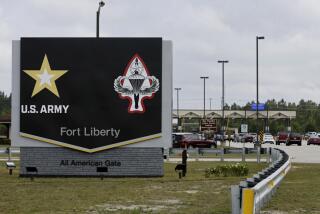New Mexico Town Offers Lesson in Hope to Cities Losing Military Bases : Economy: Roswell was “panic-stricken” after Walker Air Force Base closed in 1967, but now it’s thriving.
- Share via
ROSWELL, N.M. — Frank Kaufman remembers a time when the most successful businesses in town were moving companies.
After nearby Walker Air Force Base closed in 1967, its B-52 bombers flying low in a farewell salute, Roswell went into a tailspin, losing a third of its population.
“We were panic-stricken,” said Kaufman, a former Roswell Chamber of Commerce vice president who had been stationed at Walker. “We had mixed emotions. We thought the town would collapse.”
But 25 years later, this southeastern New Mexico city once again is brimming with neighbors chatting over back yard fences and meeting at their favorite family restaurant on Main Street.
The former military base is home to a bustling industrial park with 14 manufacturing companies, an airline pilot training program, a municipal airport, Eastern New Mexico University’s Roswell branch, and a medical rehabilitation facility.
The bottom-line message from Roswell’s leaders to the communities currently affected by the proposed closure or consolidation of 165 bases: It doesn’t have to mean economic disaster.
The Pentagon estimates its latest base-reduction plan should save millions. But officials from many of the affected areas plead that their bases are somehow unique and vital to their communities. They predict high jumps in unemployment and businesses going belly up.
When Walker closed, Roswell lost $1 million a month in military payroll alone, and many people left to search for work.
“People were moving right and left,” Chamber of Commerce executive director J. J. Johnston said. “There were a lot of tears shed. The emotional loss was devastating.”
The B-52s that roared goodby were the icons of a base that housed the 509th Bomber Group, which had dropped atomic bombs on Nagasaki and Hiroshima to end World War II.
One bomber wing went to Minot, N.D.; another went to Limestone, Me.
Community leaders were baffled by the government’s plan to close Walker based on an assessment of unappealing flight weather, since Roswell boasted a sturdy 276 days of clear to partly cloudy days.
But there was an upside to the closing, Roswell Mayor William Brainerd said: The town lost its doomsayers and crybabies.
What was left, he said, was a group of people with pride in their town and a willingness to work for it.
“The people who stayed invested time and money to bring Roswell back when it wasn’t obvious it was coming back,” Brainerd said. “It took people who were pretty self-reliant, who had faith in Roswell. They took it as their responsibility to keep the town from dying.”
Gail Harris, who was mayor in 1967, put together a team of about 20 people called the Roswell Industrial Development Corp. The team studied the base for six months and produced a plan and $300,000 from private investors to keep Roswell from becoming another Southwestern ghost town.
And it worked: The town’s population has climbed from about 34,000 in 1970 to about 45,000 today, and business is booming.
The prescription for surviving a base closure is getting everyone involved, Kaufman said.
“We got church people, business owners, laborers and minorities,” he said. “You’re lost if you don’t get the thinking of the grass-roots level. The working people felt the brunt of this thing. Some of them were going to lose their jobs. You’d be surprised how many good ideas came from it.”
Johnston advises cities to see potential in closures.
The 5,029 acres of Walker Air Force Base, four miles south of the city, became the Roswell Industrial Air Center, which employs about 3,000 people.
“Don’t look at your hangars as big white elephants,” Johnston said. “Think of them as opportunities.”
Roswell’s toughest problem was what to do with 700 base homes.
Some were renovated with money from the federal government and sold. Retirees moving to Roswell also rented some for several months while looking for permanent places to live, spurring a campaign by the chamber to recruit more retirees.
Meanwhile, the industrial center slowly built up over the years.
Longhorn Manufacturing Co., a fireworks manufacturer, became the first business to move onto the base, settling into a munitions bunker on July 1, 1967, the day the base officially closed.
Levi Strauss, which employs 720 people, moved into a large building on the air center property, though it since has moved to a larger facility just outside the center.
Another tenant, aircraft maintenance and carrier company Renown Aviation, plans to hire about 200 people in the next two years. And Collective Elegance, a vase manufacturer, leased a hangar and machine shop at the center and is hiring 200 people, Johnston said.
A major bus-manufacturing company, Transportation Manufacturing Corp., moved to the industrial park in 1974. The company at one time employed 2,250 people, but several recession-era layoffs have reduced the work force to about 1,000.
Even the runways have been put to use: Japan Airlines trains pilots on them.
“Cities facing base closures have to think globally,” Johnston said. “Think North and South America, Europe and the Pacific Rim. We have aircraft from all over the world. And we can land anything that flies.”
More to Read
Sign up for Essential California
The most important California stories and recommendations in your inbox every morning.
You may occasionally receive promotional content from the Los Angeles Times.













